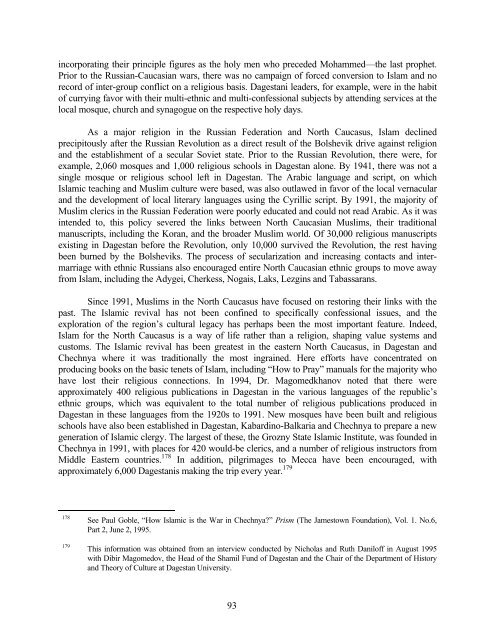RUSSIA'S TINDERBOX - Belfer Center for Science and International ...
RUSSIA'S TINDERBOX - Belfer Center for Science and International ...
RUSSIA'S TINDERBOX - Belfer Center for Science and International ...
You also want an ePaper? Increase the reach of your titles
YUMPU automatically turns print PDFs into web optimized ePapers that Google loves.
incorporating their principle figures as the holy men who preceded Mohammed—the last prophet.<br />
Prior to the Russian-Caucasian wars, there was no campaign of <strong>for</strong>ced conversion to Islam <strong>and</strong> no<br />
record of inter-group conflict on a religious basis. Dagestani leaders, <strong>for</strong> example, were in the habit<br />
of currying favor with their multi-ethnic <strong>and</strong> multi-confessional subjects by attending services at the<br />
local mosque, church <strong>and</strong> synagogue on the respective holy days.<br />
As a major religion in the Russian Federation <strong>and</strong> North Caucasus, Islam declined<br />
precipitously after the Russian Revolution as a direct result of the Bolshevik drive against religion<br />
<strong>and</strong> the establishment of a secular Soviet state. Prior to the Russian Revolution, there were, <strong>for</strong><br />
example, 2,060 mosques <strong>and</strong> 1,000 religious schools in Dagestan alone. By 1941, there was not a<br />
single mosque or religious school left in Dagestan. The Arabic language <strong>and</strong> script, on which<br />
Islamic teaching <strong>and</strong> Muslim culture were based, was also outlawed in favor of the local vernacular<br />
<strong>and</strong> the development of local literary languages using the Cyrillic script. By 1991, the majority of<br />
Muslim clerics in the Russian Federation were poorly educated <strong>and</strong> could not read Arabic. As it was<br />
intended to, this policy severed the links between North Caucasian Muslims, their traditional<br />
manuscripts, including the Koran, <strong>and</strong> the broader Muslim world. Of 30,000 religious manuscripts<br />
existing in Dagestan be<strong>for</strong>e the Revolution, only 10,000 survived the Revolution, the rest having<br />
been burned by the Bolsheviks. The process of secularization <strong>and</strong> increasing contacts <strong>and</strong> intermarriage<br />
with ethnic Russians also encouraged entire North Caucasian ethnic groups to move away<br />
from Islam, including the Adygei, Cherkess, Nogais, Laks, Lezgins <strong>and</strong> Tabassarans.<br />
Since 1991, Muslims in the North Caucasus have focused on restoring their links with the<br />
past. The Islamic revival has not been confined to specifically confessional issues, <strong>and</strong> the<br />
exploration of the region’s cultural legacy has perhaps been the most important feature. Indeed,<br />
Islam <strong>for</strong> the North Caucasus is a way of life rather than a religion, shaping value systems <strong>and</strong><br />
customs. The Islamic revival has been greatest in the eastern North Caucasus, in Dagestan <strong>and</strong><br />
Chechnya where it was traditionally the most ingrained. Here ef<strong>for</strong>ts have concentrated on<br />
producing books on the basic tenets of Islam, including “How to Pray” manuals <strong>for</strong> the majority who<br />
have lost their religious connections. In 1994, Dr. Magomedkhanov noted that there were<br />
approximately 400 religious publications in Dagestan in the various languages of the republic’s<br />
ethnic groups, which was equivalent to the total number of religious publications produced in<br />
Dagestan in these languages from the 1920s to 1991. New mosques have been built <strong>and</strong> religious<br />
schools have also been established in Dagestan, Kabardino-Balkaria <strong>and</strong> Chechnya to prepare a new<br />
generation of Islamic clergy. The largest of these, the Grozny State Islamic Institute, was founded in<br />
Chechnya in 1991, with places <strong>for</strong> 420 would-be clerics, <strong>and</strong> a number of religious instructors from<br />
Middle Eastern countries. 178 In addition, pilgrimages to Mecca have been encouraged, with<br />
approximately 6,000 Dagestanis making the trip every year. 179<br />
178 See Paul Goble, “How Islamic is the War in Chechnya?” Prism (The Jamestown Foundation), Vol. 1. No.6,<br />
Part 2, June 2, 1995.<br />
179 This in<strong>for</strong>mation was obtained from an interview conducted by Nicholas <strong>and</strong> Ruth Daniloff in August 1995<br />
with Dibir Magomedov, the Head of the Shamil Fund of Dagestan <strong>and</strong> the Chair of the Department of History<br />
<strong>and</strong> Theory of Culture at Dagestan University.<br />
93
















